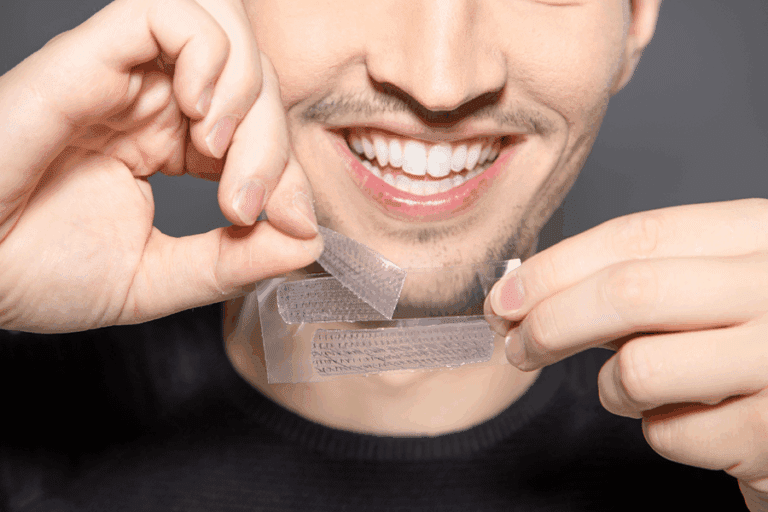A brown spot on your tooth can be unsettling. Sometimes these spots are simply stains that come from eating and drinking certain foods. Other times, a brown spot can be something more serious such as a cavity that needs treatment. How do you tell the difference between the two?
In this article, we provide tips on how to tell if you have a cavity or a stain.
Brown spots on teeth
Most people will experience a brown spot on one or more of their teeth at some point in life – some teeth even develop with a brown spot. Brown spots can be perfectly harmless – or a sign that a trip to the dentist is needed. Spotting the difference can be tricky. No matter what the reason for a new brown spot is, talking with your dentist is the best option to make sure it is taken care of. However, there are signs that can help you differentiate between a cavity and a stain.
How to tell if it is a stain
Stains on teeth are common, especially for people who frequently indulge in beverages such as coffee, wine, soda, and tea. These can slowly stain teeth over time, which can appear as brown spots or a yellow appearance to the teeth. Although they may look unsightly, stains do not necessarily cause serious damage to your teeth.
In addition to certain beverages, there are numerous other causes behind tooth stains:
- Tobacco use
- Smoking
- Aging
- Certain medications
- A buildup of plaque or tartar on teeth
Another telltale sign that you have staining rather than a cavity is that the entire tooth will have a different color, not a single spot. It’s very uncommon for a single stain spot to appear on a tooth.
Most of the time teeth stains will appear and disappear quickly. If a spot on a tooth seems to come and go, it’s likely a stain. However, if the spot does not come and go and grows over time, it’s time to go see the dentist.
How to treat stains on teeth
Stains on teeth can be annoying, but the good news is they can be treated. Many times, at-home treatments can help dramatically.
Treatments for stained teeth include:
- Reduce or cut out the foods or beverages that are causing stains on the teeth.
- Increase the number of times you brush throughout the day, especially after consuming stain-causing foods and beverages.
- Try at-home whitening treatments such as strips or whitening toothpaste.
- Consult your dentist for serious stains that are not helped by at-home treatments.
Unlike cavities which must be treated by a dentist, stains are often manageable from your home. If you are having trouble removing a stain or notice the stain is growing, it’s important to talk with an oral health professional.
How to tell if it’s a cavity
Most of the time, it’s easy to tell a cavity from a stain due to the uncomfortable side effects that come from a cavity. However, there are some situations where it’s hard to tell the difference, especially if the cavity is small. It’s important to have any new spots on a tooth checked by a dentist so that they can be treated as necessary.
What is a cavity?
Cavities are holes in teeth that grow larger over time. Also known as tooth decay or caries, they’re caused by things such as poor oral health care, eating a lot of sugary foods, and snacking throughout the day. Cavities are one of the most common oral health problems people are faced with.
Signs that it’s a cavity
Spots on your tooth or teeth that are black, brown, or gray are a sign that a cavity is growing. However, there are many other symptoms that indicate it is a cavity rather than a stain:
- Visible holes in the teeth. If you notice a hole in your tooth, it’s a cavity. Stains don’t cause holes in teeth.
- Increase in tooth pain. Although at the beginning tooth pain may come and go, it will become constant if the cavity is not treated. Pain caused by a cavity can radiate to other parts of your body including the jaw and ears. Any tooth pain should be evaluated by a dentist.
- New sensitivity: If drinking an ice-cold beverage or biting into a steaming meal makes you squirm, it could be a sign that you have a cavity. This is because the tooth enamel is breaking down and can expose sensitive parts of your teeth.
How to treat a cavity
Cavities must always be treated by a dentist. Only a dentist has the proper tools and experience to fill a cavity. Unlike stains, cavities cannot be treated at home.
During a cavity treatment, your dentist will either perform a filling, dental crown, or root canal depending on the severity of the tooth decay.
- Filling: Getting a filling is the most common way a cavity is treated. During the procedure, a dentist will remove the damaged parts of the tooth and fill it with resin that matches the tooth color. This is done painlessly with the help of numbing medication.
- Dental crown: In some cases, a cavity destroys a large amount of the tooth and it’s no longer able to be fixed with a filling. A dental crown helps fill the gap. Dental crowns are tooth-shaped “caps” that are adhered to the healthy, natural tooth structure.
- Root canal: Root canals sound scary but are a painless procedure that helps in cases where the cavity has advanced deep enough to reach the nerve in the tooth.
It’s important to get cavities treated as soon as possible to reduce any pain or other complications that come with them. Remember to contact your dental office as soon as you think you may have a cavity to be evaluated.
Whether it’s a cavity or a stain, seeing a dentist annually can help prevent both. Be sure to reach out with any oral health concerns, no matter how small it seems.



